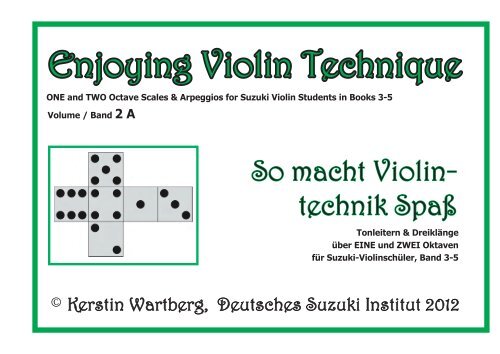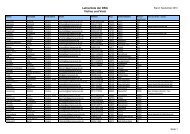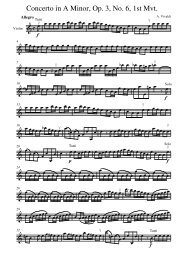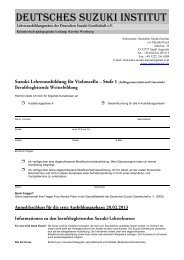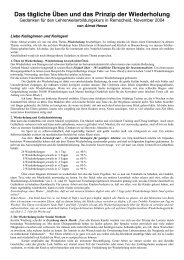Enjoying Violin Technique - Germansuzuki.de
Enjoying Violin Technique - Germansuzuki.de
Enjoying Violin Technique - Germansuzuki.de
Create successful ePaper yourself
Turn your PDF publications into a flip-book with our unique Google optimized e-Paper software.
<strong>Enjoying</strong> <strong>Violin</strong> <strong>Technique</strong><br />
ONE and TWO Octave Scales & Arpeggios for Suzuki <strong>Violin</strong> Stu<strong>de</strong>nts in Books 3-5<br />
Volume / Band 2 A<br />
So macht <strong>Violin</strong>-<br />
technik Spaß<br />
Tonleitern & Dreiklänge<br />
über EINE und ZWEI Oktaven<br />
für Suzuki-<strong>Violin</strong>schüler, Band 3-5<br />
© Kerstin Wartberg, Deutsches Suzuki Institut 2012
Piano Arrangements Klavierarrangements<br />
David Andruss<br />
www.musicdownloaddirect.<strong>de</strong><br />
Piano accompaniments to<br />
<strong>Enjoying</strong> <strong>Violin</strong> <strong>Technique</strong><br />
available for download.<br />
Hier können Klavierbegleitungen zu<br />
So macht <strong>Violin</strong>technik Spaß<br />
herunter gela<strong>de</strong>n wer<strong>de</strong>n.<br />
© Deutsches Suzuki Institut 2012
Contents - Inhalt<br />
Rhythm Variations Rhythmus-Variationen Page/Seite<br />
1 Octave Scales Tonleitern über 1 Oktave 6<br />
1 Octave Arpeggios Dreiklänge über 1 Oktave 7<br />
2 Octave Scales Tonleitern über 2 Oktaven 8<br />
2 Octave Arpeggios Dreiklänge über 2 Oktaven 10<br />
Scales & Arpeggios Tonleitern & Dreiklänge<br />
1. G Major, 1st position G-Dur, 1. Lage Level 1 12<br />
2. A Major, 1st position A-Dur, 1. Lage Level 1 13<br />
3. B b Major, 1st position B-Dur, 1. Lage Level 1 14<br />
4. B b Major, 2nd position B-Dur, 2. Lage Level 2 15<br />
5. C Major, 1st position C-Dur, 1. Lage Level 2 16<br />
6. C Major, 2nd position C-Dur, 2. Lage Level 2 17<br />
7. C Major, 3rd position C-Dur, 3. Lage Level 2 18<br />
8. D Major, 1st + 3rd positions D-Dur, 1. + 3. Lage Level 1 19<br />
9. D Major, 3rd position D-Dur, 3. Lage Level 2 20<br />
10. E b Major, 1st + 4th positions Es -Dur, 1. + 4. Lage Level 3 21<br />
11. E Major, 1st + 4th positions E-Dur, 1. + 4. Lage Level 2 22<br />
12. F Major, (1st) 2nd + 5th positions F-Dur, (1.) 2. + 5. Lage Level 3 23<br />
13. G Minor melodic, 1st position g-Moll melodisch, 1. Lage Level 1 24<br />
14. A Minor melodic, 1st position a-Moll melodisch, 1. Lage Level 1 25<br />
15. D Minor melodic, 1st + 3rd positions d-Moll melodisch, 1. + 3. Lage Level 2 26<br />
16. E Minor harmonic, 1st + 4th positions e-Moll harmonisch, 1. + 4. Lage Level 2 27<br />
Scales & Arpeggios Tonleitern & Dreiklänge<br />
Key Cards Tonarten-Kärtchen 28<br />
Practice Cards Übe-Kärtchen 33
Dear <strong>Violin</strong> Teachers, Dear Parents,<br />
This book of technical exercises on one- and two-octave scales and<br />
arpeggios is inten<strong>de</strong>d for Suzuki stu<strong>de</strong>nts working on Volumes 3 to 5.<br />
Its object is to offer an enjoyable method for familiarizing stu<strong>de</strong>nts with<br />
these more or less unpopular exercises. Its playful character as well as<br />
the numerous technical applications aim at giving new life to rigid<br />
practicing and teaching routines.<br />
You probably will ask yourselves how practicing scales and arpeggios<br />
could be “enjoyable”. Quite simple! We shall link practice to<br />
interactive, playful elements. To this end we use dice as well as the key<br />
and practice cards from this book, see pages 28 — 34. To make these<br />
cards more hard-wearing, it would be a good i<strong>de</strong>a to copy the entire<br />
page, to laminate it and then cut out the individual cards.<br />
The cards and dice invite you to take part in numerous activities. If, for<br />
instance, a certain key is to be learned, all one- and two-octave scales<br />
and arpeggios should be practiced with different rhythms. The number<br />
of eyes on the die will <strong>de</strong>termine the rhythm, see pages 6 -11.<br />
The die may also indicate how many FAULTLESS repetitions should<br />
be practiced. During group classes, the children may throw the die for<br />
themselves or for a fellow stu<strong>de</strong>nt. This will liven up the lesson and,<br />
subsequently, improve concentration.<br />
As soon as reliable results have been achieved in a certain key, the<br />
practice cards on pages 33 and 34 may be used. They indicate special<br />
points of emphasis like posture, intonation or tone quality.<br />
Only if FAULTLESS repetition and a beautiful tone are at the centre<br />
of practice, good violin skills may be acquired and absorbed for later<br />
easy recall.<br />
After several scales and arpeggios have been learned, the key cards shall<br />
be used. They will be placed into a box, and the child may take a card.<br />
This game will help the child to get used to regular repetition of the<br />
scales and arpeggios studied so far.<br />
The key cards are grouped in three levels:<br />
LEVEL 1: Suzuki Volume 3, One- and Two-Octave Scales & Arpeggios<br />
LEVEL 2: Suzuki Volume 4, One- and Two-Octave Scales & Arpeggios<br />
LEVEL 3: Suzuki Volume 5, One- and Two-Octave Scales & Arpeggios<br />
In addition, three-octave scales should be used from Volume 5 onwards.<br />
They are, however, not inclu<strong>de</strong>d here.<br />
The key cards allow the child and its parents to gain an overview of the<br />
scales and arpeggios for their particular level, whereas the practice cards<br />
specify important practice points. The die is used to liven up the lesson<br />
and to create excitement. Employing these small aids sparingly and<br />
sensibly to <strong>de</strong>velop creative little practice games will contribute towards<br />
a lively and focussed learning environment.<br />
Another way to promote a child’s motivation for practicing is to play<br />
with piano accompaniment. Downloads are available for piano<br />
accompaniments in all keys, contributing towards the pleasure of shared<br />
learning during group lessons.<br />
I would like to encourage all teachers to arrange one group lesson on<br />
technique per month, preparing its teaching content during individual<br />
classes. Wishing you and the children an enjoyable time building a stable<br />
violin technique, according to the slogan a joy shared is a double joy!<br />
Kerstin Wartberg<br />
4
Das vorliegen<strong>de</strong> Technikheft mit Tonleitern und Dreiklängen über<br />
eine und zwei Oktaven richtet sich an Suzuki-Schüler <strong>de</strong>r Bän<strong>de</strong> 3 bis 5.<br />
Es will auf vergnügliche Weise <strong>de</strong>n Schülern diese oft ungeliebten<br />
Übungen nahe bringen. Sowohl <strong>de</strong>r spielerische Charakter als auch die<br />
zahlreichen technischen Umsetzungsmöglichkeiten erfrischen die<br />
häufig festgefahrene Routine beim Üben und im Unterricht.<br />
Sie fragen sich bestimmt, wie das Üben von Tonleitern und Dreiklängen<br />
„vergnüglich“ sein kann Ganz einfach! Wir verbin<strong>de</strong>n es mit spielerischen<br />
Elementen. Dazu benötigen wir einen Würfel sowie die<br />
Tonarten- und die Übe-Kärtchen aus diesem Heft. (Siehe S. 28 — 34)<br />
Um <strong>de</strong>n Kärtchen ein längeres Leben zu verleihen, ist es sinnvoll, die<br />
gesamte Seite zu kopieren, sie zu laminieren und danach in Kärtchen zu<br />
schnei<strong>de</strong>n.<br />
Die Kärtchen und <strong>de</strong>r Würfel la<strong>de</strong>n zu zahlreichen Aktivitäten ein. Soll<br />
beispielsweise eine bestimmte Tonart erlernt wer<strong>de</strong>n, können diese<br />
ein- und zweioktavigen Tonleitern und Dreiklänge mit verschie<strong>de</strong>nen<br />
Rhythmen geübt wer<strong>de</strong>n. Die Anzahl <strong>de</strong>r Würfelaugen bestimmt <strong>de</strong>n<br />
Rhythmus. (Siehe Seite 6 -11).<br />
Der Würfel kann aber auch anzeigen, wie viele FEHLERFREIE<br />
Wie<strong>de</strong>rholungen geübt wer<strong>de</strong>n sollen. In <strong>de</strong>n Gruppenstun<strong>de</strong>n dürfen<br />
die Kin<strong>de</strong>r für sich selbst o<strong>de</strong>r für einen Mitschüler würfeln. Das bringt<br />
immer wie<strong>de</strong>r eine Auflockerung und das aufmerksame Üben fällt<br />
danach wie<strong>de</strong>r leichter.<br />
Sobald eine Ablaufsicherheit für eine bestimmte Tonart erreicht ist,<br />
können die Übe-Kärtchen eingesetzt wer<strong>de</strong>n. Sie sind in <strong>de</strong>m Heft auf<br />
<strong>de</strong>n Seiten 33 und 34 zu fin<strong>de</strong>n. Hierauf stehen beson<strong>de</strong>re<br />
Schwerpunkte geschrieben, die die Konzentration gezielt auf EIN<br />
EINZIGES THEMA aus <strong>de</strong>n Bereichen Haltung, Intonation o<strong>de</strong>r<br />
Tonqualität lenken soll. Gute geigerische Fähigkeiten zu erwerben, sie<br />
zu verinnerlichen und später wie<strong>de</strong>r ungestört abzurufen, ist nur dann<br />
möglich, wenn beim Üben das FEHLERFREIE, TONSCHÖNE<br />
Wie<strong>de</strong>rholen eine so zentrale Rolle spielt.<br />
Liebe Geigenlehrer! Liebe Schülereltern!<br />
Kerstin Wartberg<br />
Nach<strong>de</strong>m mehrere Tonleitern und Dreiklänge erlernt wor<strong>de</strong>n sind,<br />
kommen die Tonarten-Kärtchen zum Einsatz. Sie wer<strong>de</strong>n in ein Kästchen<br />
gelegt und das Kind darf eine Karte ziehen. Durch dieses Spiel gewöhnt<br />
es sich leicht daran, alle bisher erlernten Tonleitern und Dreiklänge<br />
regelmäßig zu wie<strong>de</strong>rholen.<br />
Die Tonarten-Kärtchen sind in drei Niveaustufen unterteilt:<br />
LEVEL 1: Suzuki Band 3, Tonleitern & Dreiklänge über EIN<br />
und ZWEI Oktaven<br />
LEVEL 2: Suzuki Band 4, Tonleitern & Dreiklänge über EIN<br />
und ZWEI Oktaven<br />
LEVEL 3: Suzuki Band 5, Tonleitern & Dreiklänge über EIN<br />
und ZWEI Oktaven<br />
Übrigens sollten ab Band 5 auch Tonleitern über drei Oktaven hinzu<br />
genommen wer<strong>de</strong>n. Diese sind hier aber nicht mit einbezogen.<br />
Die Tonarten-Kärtchen geben <strong>de</strong>m Kind und <strong>de</strong>n Eltern einen<br />
Überblick über die konkreten Tonleitern & Dreiklänge ihrer Stufe<br />
und die Übe-Kärtchen ver<strong>de</strong>utlichen wichtige Übethemen. Der Würfel<br />
sorgt für Auflockerung und Spannung. Wer diese kleinen Mittel dosiert<br />
und sinnvoll einsetzt, kann viele kreative Übespielchen entwickeln und<br />
Weichen für eine lebendige und konzentrierte Lernatmosphäre stellen.<br />
Eine weitere Übemotivation ist das Spielen mit Klavierbegleitung. Für<br />
alle Tonarten stehen Klavierbegleitungen als Download zur Verfügung,<br />
die beson<strong>de</strong>rs in <strong>de</strong>n Gruppenstun<strong>de</strong>n die Freu<strong>de</strong> am gemeinsamen<br />
Lernen för<strong>de</strong>rn.<br />
Abschließend möchte ich alle Lehrer anregen, einmal im Monat eine<br />
Technik-Gruppenstun<strong>de</strong> anzusetzen und <strong>de</strong>ren Inhalte im<br />
Einzelunterricht vorzubereiten. Unter <strong>de</strong>m Motto Gemeinsam ist es<br />
schöner! wünsche ich Ihnen und <strong>de</strong>n Kin<strong>de</strong>rn eine vergnügliche Zeit<br />
beim Aufbau einer stabilen Geigentechnik.<br />
5
6<br />
1 Octave Scales - Tonleitern über 1 Oktave
1 Octave Arpeggios g - Dreiklänge e über 1 Oktave<br />
7
8<br />
2 Octave Scales - Tonleitern e n über 2 Oktaven
2 Octave Scales - Tonleitern e n über 2 Oktaven<br />
9
10<br />
2 Octave Arpeggios g - Dreiklänge e über 2 Oktaven
2 Octave Arpeggios g - Dreiklänge e über 2 Oktaven<br />
11
12<br />
G Major 1 st position G-Dur 1. Lage
A Major 1 st position A-Dur 1. Lage<br />
13
B b<br />
Major 1 st position B-Dur 1. Lage<br />
14
B b<br />
Major 2 nd position B-Dur 2. Lage<br />
15
16<br />
C Major 1 st position C-Dur 1. Lage
C Major 2 nd position C-Dur 2. Lage<br />
17
18<br />
C Major 3 rd position C-Dur 3. Lage
D Major 1 st + 3 rd positions D-Dur D 1. + 3. Lage<br />
19
20<br />
D Major 3 rd position D-Dur D 3. Lage
E b Major 1 st + 4 th positions Es-Dur 1. + 4. Lage<br />
21
22<br />
E Major 1 st + 4 th positions E-Dur 1. + 4. Lage
F Major (1 st ), 2 nd + 5 th positions F-Dur (1.), 2. + 5. Lage<br />
23
24<br />
G Minor melodic, 1 st position g-Moll l melodisch, 1. Lage
A Minor melodic, 1 st position a-Moll l melodisch, 1. Lage<br />
25
26<br />
D Minor melodic, 1 st + 3 rd positions d-Moll l melodisch, 1. + 3. Lage
E Minor harmonic, 1 st + 4 th positions e-Moll l harmonisch, 1. + 4. Lage<br />
27
Laminate and<br />
✂ then cut out!<br />
Laminieren und dann ausschnei<strong>de</strong>n!<br />
)<br />
LEVEL 1A: Key Cards Tonarten-Kärtchen<br />
A Minor (melodic)<br />
a-Moll (melodisch)<br />
lower octave - untere Oktave<br />
A Minor (melodic)<br />
a-Moll (melodisch)<br />
upper octave - obere Oktave<br />
G Minor (melodic)<br />
g-Moll (melodisch)<br />
lower octave - untere Oktave<br />
G Minor (melodic)<br />
g-Moll (melodisch)<br />
upper octave - obere Oktave<br />
B b Major<br />
B-Dur<br />
lower octave - untere Oktave<br />
B b Major<br />
B-Dur<br />
upper octave - obere Oktave<br />
28
)<br />
LEVEL 1B: Key Cards Tonarten-Kärtchen<br />
G Major (2 octaves)<br />
G-Dur (2 Oktaven)<br />
A Major (2 octaves)<br />
A-Dur (2 Oktaven)<br />
G Minor (2 octaves)<br />
g-Moll (2 Oktaven)<br />
melodic - melodisch<br />
A Minor (2 octaves)<br />
a-Moll (2 Oktaven)<br />
melodic - melodisch<br />
B b Major (2 octaves)<br />
B-Dur (2 Oktaven)<br />
D Major (2 octaves)<br />
D-Dur (2 Oktaven)<br />
1 st + 3 rd positions - 1. + 3. Lage<br />
29
)<br />
LEVEL 2A: Key Cards Tonarten-Kärtchen<br />
C Major (2 octaves)<br />
C-Dur (2 Oktaven)<br />
C Major (2 octaves)<br />
C-Dur (2 Oktaven)<br />
1 st position - 1. Lage 2 nd position - 2. Lage<br />
C-C<br />
C Major (2 octaves)<br />
Dur (2 Oktaven)<br />
3 rd position - 3. Lage<br />
B b Major (2 octaves)<br />
B-Dur (2 Oktaven)<br />
2 nd position - 2. Lage<br />
D Major (2 octaves)<br />
D-Dur (2 Oktaven)<br />
3 rd position - 3. Lage<br />
D Minor (2 octaves)<br />
d-Moll (2 Oktaven)<br />
melodic - melodisch<br />
30
)<br />
LEVEL 2B: Key Cards Tonarten-Kärtchen<br />
E Major (1 st position)<br />
E-Dur (1. Lage)<br />
lower octave - untere Oktave<br />
E Minor (harmonic)<br />
e-Moll (harmonisch)<br />
lower octave - untere Oktave<br />
E Major (4 th position)<br />
E-Dur (4. Lage)<br />
upper octave - obere Oktave<br />
E Minor (harmonic)<br />
e-Moll (harmonisch)<br />
upper octave - obere Oktave<br />
E Major (2 octaves)<br />
E-Dur (2 Oktaven)<br />
1 st + 4 th positions - 1. + 4. Lage<br />
E Minor (2 oktaves)<br />
e-Moll (2 Oktaven)<br />
1 st + 4 th positions - 1. + 4. Lage<br />
31
LEVEL 3: Key Cards Tonarten-Kärtchen<br />
)<br />
E b Major (1 st position)<br />
Es-Dur (1. Lage)<br />
lower octave - untere Oktave<br />
F Major (2 nd position)<br />
F-Dur (2. Lage)<br />
lower octave - untere Oktave<br />
E b Major (4 th position)<br />
Es-Dur (4. Lage)<br />
upper octave - obere Oktave<br />
F Major (5 th position)<br />
F-Dur (5. Lage)<br />
upper octave - obere Oktave<br />
E b Major (2 octaves)<br />
Es-Dur (2 Oktaven)<br />
1 st + 4 th positions - 1. + 4. Lage<br />
F Major (2 oktaves)<br />
F-Dur (2 Oktaven)<br />
2 nd + 5 th positions - 2. + 5. Lage<br />
32
Practice Cards Übe-Kärtchen<br />
Good tall body posture<br />
Gute aufrechte Körperhaltung<br />
lower octave - untere Oktave<br />
Good violin posture<br />
Gute Geigenhaltung<br />
Good left thumb position<br />
Gute linke Daumenhaltung<br />
Good right thumb position<br />
Gute rechte Daumenhaltung<br />
Left elbow swinging<br />
Armsteuerung (links)<br />
Good left hand postion<br />
with the 4 th finger over the string<br />
Gute linke Handhaltung<br />
mit <strong>de</strong>m 4. Finger über <strong>de</strong>r Saite<br />
33
Practice Cards Übe-Kärtchen<br />
Contact point<br />
Kontaktstelle<br />
lower octave - untere Oktave<br />
Even bow speed<br />
Gleichmäßige<br />
Bogengeschwindigkeit<br />
Intonation<br />
Clear rhythm<br />
Klarer Rhythmus<br />
Clear sound<br />
Klarer Ton<br />
Beautiful tone quality<br />
Schöne Tongebung<br />
34
Practice Cards Übe-Kärtchen<br />
<br />
--------------------------------------------------------------------------------------- lower octave - untere Oktave ---------------------------------------------------------------------------------------<br />
--------------------------------------------------------------------------------------- ---------------------------------------------------------------------------------------<br />
--------------------------------------------------------------------------------------- ---------------------------------------------------------------------------------------<br />
35
Supplementary Material for Suzuki <strong>Violin</strong> Stu<strong>de</strong>nts<br />
STEP BY STEP<br />
An Introduction to Successful Practice<br />
<strong>Violin</strong> Exercise Books with Companion CDs<br />
by Kerstin Wartberg<br />
Alfred Publications<br />
The CDs inclu<strong>de</strong> almost all pieces from the Suzuki<br />
<strong>Violin</strong> School, volumes 1-3, in various tempi as well as<br />
important preparatory exercises and additional pieces.<br />
• Volumes 1A & 1B are suitable<br />
for stu<strong>de</strong>nts in Suzuki Book 1.<br />
• Volumes 2A & 2B are suitable<br />
for stu<strong>de</strong>nts in Suzuki Book 2.<br />
• Volumes 3A & 3B are suitable<br />
for stu<strong>de</strong>nts in Suzuki Book 3.<br />
• Piano Accompaniments: www.musicdownloaddirect.<strong>de</strong><br />
The STRAD, September 2005:<br />
This fascinating series of tutor books is closely based on the Suzuki <strong>Violin</strong> Method. The series is suitable for teachers well versed in the Suzuki method, but will also be of<br />
interest to those coming to it fresh, because of Wartberg's <strong>de</strong>tailed notes.<br />
I liked the useful advice for teachers and parents, … and the <strong>de</strong>scriptions of some effective technical exercises, which all looked great fun. The quality of the CD performances is<br />
good, with some interesting sound effects and drum rhythms that are sure to engage younger players…<br />
EP11291 EP11292<br />
RECITAL TRAINING<br />
<strong>Violin</strong> Repertoire Books with Companion CDs<br />
by Kerstin Wartberg<br />
Edition Peters<br />
The CDs inclu<strong>de</strong> all pieces from the Suzuki <strong>Violin</strong><br />
School, volumes 4 and 5, in various tempi as well as<br />
important preparatory exercises and additional pieces.<br />
• Volume 1 is suitable for stu<strong>de</strong>nts in<br />
Suzuki Book 4.<br />
• Volume 2 is suitable for stu<strong>de</strong>nts in<br />
Suzuki Book 5.<br />
Coming soon: Volume 3 for stu<strong>de</strong>nts in<br />
Suzuki Book 6.<br />
Here you will find further materials: www.musicdownloaddirect.<strong>de</strong>


